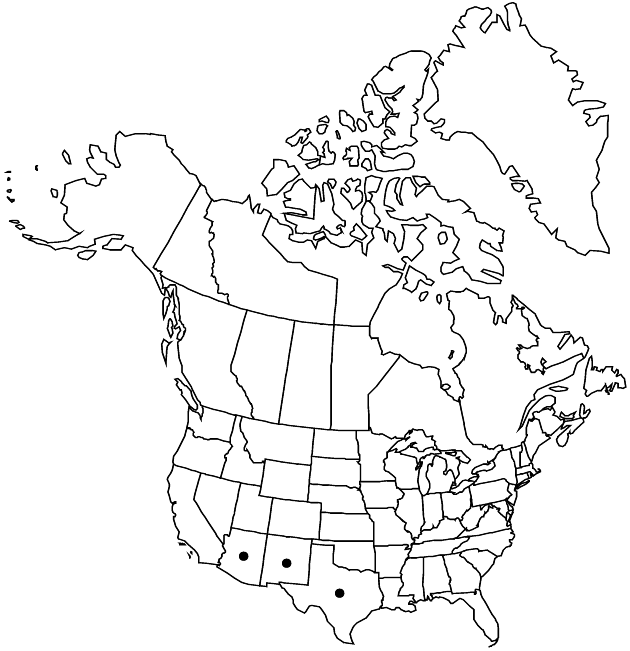Difference between revisions of "Acourtia nana"
Phytologia 27: 230. 1973.
FNA>Volume Importer |
imported>Volume Importer |
||
| (6 intermediate revisions by 2 users not shown) | |||
| Line 8: | Line 8: | ||
}} | }} | ||
|common_names=Desert holly;dwarf desertpeony | |common_names=Desert holly;dwarf desertpeony | ||
| − | |basionyms={{Treatment/ID/ | + | |basionyms={{Treatment/ID/Basionym |
|name=Perezia nana | |name=Perezia nana | ||
|authority=A. Gray | |authority=A. Gray | ||
| + | |rank=species | ||
| + | |publication_title=Mem. Amer. Acad. Arts, n. s. | ||
| + | |publication_place=4: 111. 1849 | ||
}} | }} | ||
|synonyms= | |synonyms= | ||
| Line 27: | Line 30: | ||
|elevation=0–1800 m | |elevation=0–1800 m | ||
|distribution=Ariz.;N.Mex.;Tex.;Mexico (Chihuahua;Coahuila;Nuevo León;San Luis Potosí;Sonora;Zacatecas). | |distribution=Ariz.;N.Mex.;Tex.;Mexico (Chihuahua;Coahuila;Nuevo León;San Luis Potosí;Sonora;Zacatecas). | ||
| − | |discussion=<p>Acourtia nana grows primarily in the trans-Pecos and western Edwards Plateau.</p> | + | |discussion=<p><i>Acourtia nana</i> grows primarily in the trans-Pecos and western Edwards Plateau.</p> |
|tables= | |tables= | ||
|references= | |references= | ||
| Line 36: | Line 39: | ||
-->{{#Taxon: | -->{{#Taxon: | ||
name=Acourtia nana | name=Acourtia nana | ||
| − | |||
|authority=(A. Gray) Reveal & R. M. King | |authority=(A. Gray) Reveal & R. M. King | ||
|rank=species | |rank=species | ||
| Line 51: | Line 53: | ||
|publication year=1973 | |publication year=1973 | ||
|special status= | |special status= | ||
| − | |source xml=https:// | + | |source xml=https://bitbucket.org/aafc-mbb/fna-data-curation/src/2e0870ddd59836b60bcf96646a41e87ea5a5943a/coarse_grained_fna_xml/V19-20-21/V19_7.xml |
|tribe=Asteraceae tribe Mutisieae | |tribe=Asteraceae tribe Mutisieae | ||
|genus=Acourtia | |genus=Acourtia | ||
Latest revision as of 20:54, 5 November 2020
Plants 2.5–30 cm, (divaricately branching). Leaves cauline; sessile; blades rhombic-orbiculate to suborbiculate, 10–50 mm, bases cuneate, margins coarsely and irregularly prickly-dentate, faces glabrous (reticulate). Heads borne singly (at branch tips). Involucres campanulate, 14–17 mm. Phyllaries in 4 series, broadly ovate, margins glandular, apices acute to mucronate, abaxial faces glabrous. Receptacles reticulate (sockets separated by squarish, apically pubescent paleae 1 mm). Florets 15–24; corollas lavender-pink or white, 10–17 mm. Cypselae subcylindric, 3–7.5 mm, densely stipitate-glandular; pappi white or tawny, 10–15 mm. 2n = 54.
Phenology: Flowering (Mar–)Apr(–Jun).
Habitat: Gravel, sandstone, silty, or caliche soils in desert scrub
Elevation: 0–1800 m
Distribution

Ariz., N.Mex., Tex., Mexico (Chihuahua, Coahuila, Nuevo León, San Luis Potosí, Sonora, Zacatecas).
Discussion
Acourtia nana grows primarily in the trans-Pecos and western Edwards Plateau.
Selected References
None.